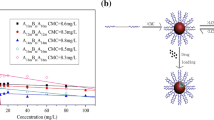Abstract
Thermosensitive polymers play an important role in controlled drug delivery and other biomedical and biotechnology applications. Thermosensitive polymers and copolymers that contain free reactive groups provide further possibilities in the field of targeted therapy. A high concentration of free amino groups in copolymers allows for the immobilization of various biosubstances, e.g., drugs, proteins or polysaccharides. Copolymers containing free amino groups were prepared via the cationic copolymerization of 2-ethyl-2-oxazoline with 2-(4-aminophenyl)-2-oxazoline. The mechanism of copolymerization was studied via a model polymerization of 2-ethyl-2-oxazoline in the presence of ethyl 4-aminobenzoate (EAB) as the source of the aromatic amino group. These model polymerizations showed that EAB incorporated into the polymer via a termination step. The studies also showed that the molar mass of the formed polymers depended on the ratio of initiator to EAB. The composition of the prepared copolymers was determined by NMR and absorbance spectroscopy. The prepared copolymers exhibited decreasing phase transition temperatures with increasing concentrations of aromatic units, which were confirmed by optical transmittance measurements. The influence of the concentration of copolymers, the presence of surfactants and the presence of an inorganic salt on the thermosensitive properties of the prepared copolymers was also demonstrated.












Similar content being viewed by others
References
Jeong B, Gutowska A (2002) Lessons from nature: stimuli-responsive polymers and their biomedical applications. Trends in Biotechnology 20:305–311. doi:10.1016/S0167-7799(02)01962-5
Kono K (2001) Thermosensitive polymer-modified liposomes. Adv Drug Deliv Rev 53:307–319. doi:10.1016/S0169-409X(01)00204-6
Rosler A, Vandermeulen GWM, Klok HA (2001) Advanced drug delivery devices via self-assembly of amphiphilic block copolymers. Adv Drug Deliv Rev 53:95–108. doi:10.1016/S0169-409X(01)00222-8
Qiu Y, Park K (2001) Environment-sensitive hydrogels for drug delivery. Adv Drug Deliv Rev 53:321–339. doi:10.1016/S0169-409X(01)00203-4
Christova D, Velichkova R, Loos W, Goethals EJ, Du Prez F (2003) New thermo-responsive polymer materials based on poly(2-ethyl-2-oxazoline) segments. Polymer 44:2255–2261. doi:10.1016/S0032-3861(03)00139-3
Huber S, Jordan R (2008) Modulation of the lower critical solution temperature of 2-Alkyl-2-oxazoline copolymers. Colloid Polym Sci 286:395–402. doi:10.1007/s00396-007-1781-y
Huber S, Hutter N, Jordan R (2008) Effect of end group polarity upon the lower critical solution temperature of poly(2-isopropyl-2-oxazoline). Colloid Polym Sci 286:1653–1661. doi:10.1007/s00396-008-1942-7
Zhang N, Huber S, Schulz A, Luxenhofer R, Jordan R (2009) Cylindrical molecular brushes of poly(2-oxazoline)s from 2-isopropenyl-2-oxazoline. Macromolecules 42:2215–2221. doi:10.1021/ma802627y
Park JS, Akiyama Y, Winnik FM, Kataoka K (2004) Versatile synthesis of end-functionalized thermosensitive poly(2-isopropyl-2-oxazolines). Macromolecules 37:6786–6792. doi:10.1021/ma049677n
Hoogenboom R, Thijs HML, Wouters D, Hoeppener S, Schubert US (2008) Solvent responsive micelles based on block and gradient copoly(2-oxazoline)s. Macromolecules 41:1581–1583. doi:10.1021/ma702801e
Gross A, Maier G, Nuyken O (1996) Synthesis and copolymerization of macromonomers based on 2-nonyl- and 2-phenyl-2-oxazoline. Macromol Chem Phys 197:2811–2826
Hoogenboom R, Thijs HML, Fijten MWM, Van Lankvelt BM, Schubert US (2007) One-pot synthesis of 2-phenyl-2-oxazoline-containing quasi-diblock copoly(2-oxazoline)s under microwave irradiation. J Polym Sci Polym Chem 45:416–422. doi:10.1002/pola.21711
Diehl C, Schlaad H (2009) Thermo-responsive polyoxazolines with widely tuneable LCST. Macromol Biosci 9:157–161. doi:10.1002/mabi.200800213
Bloksma MM, Schubert US, Hoogenboom R (2011) Poly(cyclic imino ether)s beyond 2-substituted-2-oxazolines. Macromol Rapid Commun 32:1419–1441
Bloksma MM, Bakker DE, Weber C, Hoogenboom R, Schubert US (2010) The effect of hofmeister salts on the LCST transition of poly(2-oxazoline)s with varying hydrophilicity. Macromol Rapid Commun 31:724–728. doi:10.1002/marc.201100138
Kowalczuk A, Kronek J, Bosowska K, Trzebicka B, Dworak A (2011) Star poly(2-ethyl-2-oxazoline)s-synthesis and thermosensitivity. Polym Int 60:1001–1009. doi:10.1002/pi.3103
Weber C, Hoogenboom R, Schubert US (2012) Temperature responsive bio-compatible polymers based on poly(ethylene oxide) and poly(2-oxazoline)s. Prog Polym Sci 37:686–714. doi:10.1016/j.progpolymsci.2011.10.002
Cesana S, Auernheimer J, Jordan R, Kessler H, Nuyken O (2006) First poly(2-oxazoline)s with pendant amino groups. Macromol Chem Phys 207:183–192. doi:10.1002/macp.200500495
Zarka MT, Nuyken O, Weberskirch R (2003) Amphiphilic polymer supports for the asymmetric hydrogenation of amino acid precursors in water. Chem Eur J 9:3228–3234. doi:10.1002/chem.200304729
Cesana S, Kurek A, Baur MA, Auernheimer J, Nuyken O (2007) Polymer-bound thiol groups on poly(2-oxazoline)s. Macromol Rapid Commun 28:608–615. doi:10.1002/marc.200600737
Taubmann C, Luxenhofer R, Cesana S, Jordan R (2005) First aldehyde-functionalized poly(2-oxazoline)s for chemoselective ligation. Macromol Biosci 5:603–612. doi:10.1002/mabi.200500059
Kronek J, Lustoň J, Kroneková Z, Paulovičová E, Farkaš P, Petrenčíková N, Paulovičová L, Janigová I (2010) Synthesis and bioimmunological efficiency of poly(2-oxazolines) containing a free amino group. J Mater Sci Mater Med 21:879–886. doi:10.1007/s10856-009-3949-0
Kronek J, Kroneková Z, Lustoň J, Paulovičová E, Paulovičová L, Mendrek B (2011) In vitro bio-immunological and cytotoxicity studies of poly(2-oxazolines). J Mater Sci Mater Med 22:1725–1734. doi:10.1007/s10856-011-4346-z
Farkaš P, Korcová J, Kronek J, Bystrický S (2010) Preparation of synthetic polyoxazoline based carrier and Vibrio cholerae O-specific polysaccharide conjugate vaccine. Eur J Med Chem 45:795–799. doi:10.1016/j.ejmech.2009.11.002
Korcová J, Machová E, Farkaš P, Bystrický S (2010) Immunomodulative properties of conjugates composed of detoxified lipopolysaccharide and capsular polysaccharide of Vibrio cholerae O135 bound to BSA-protein carrier. Biologia 65:768–775. doi:10.2478/s11756-010-0092-9
Guillerm B, Monge S, Lapinte V, Robin JJ (2012) How to modulate chemical structure of polyoxazolines by appropriate functionalization. Macromol Rapid Commun 33:1600–1612. doi:10.1002/marc.201200266
Kawaguchi T, Kojima Y, Osa M, Yoshizaki T (2008) Cloud points in aqueous poly(N-isopropylacrylamide) solutions. Polym J 40:455–459. doi:10.1295/polymj.PJ2007227
Tiera VAD, Tiera MJ, Vieira NAB, do Amaral BR, Pires RZ (2009) The interaction between N-isopropylacrylamide-acrylic acid-ethyl methacrylate thermosensitive polymers and cationic surfactants. J Disper Sci Technol 30:1121–1128. doi:10.1080/01932690802701499
Jamroz-Piegza M, Utrata-Wesolek A, Trzebicka B, Dworak A (2006) Hydrophobic modification of high molar mass polyglycidol to thermosensitive polymers. Eur Polym J 42:2497–2506. doi:10.1016/j.eurpolymj.2006.04.017
Acknowledgments
The authors appreciate the financial support of the Slovak Scientifical Agency VEGA through Project No. 2/0151/12. This study was also supported by the Slovak Research and Development Agency APVV through Project No. APVV-SK-BG-0038-10.
Author information
Authors and Affiliations
Corresponding author
Rights and permissions
About this article
Cite this article
Kronek, J., Petrenčíková, N., Mikulec, M. et al. Structure analysis and thermosensitive properties of copolymers prepared from 2-ethyl-2-oxazoline and 2-(4-aminophenyl)-2-oxazoline. Polym. Bull. 72, 1081–1094 (2015). https://doi.org/10.1007/s00289-015-1323-6
Received:
Revised:
Accepted:
Published:
Issue Date:
DOI: https://doi.org/10.1007/s00289-015-1323-6




